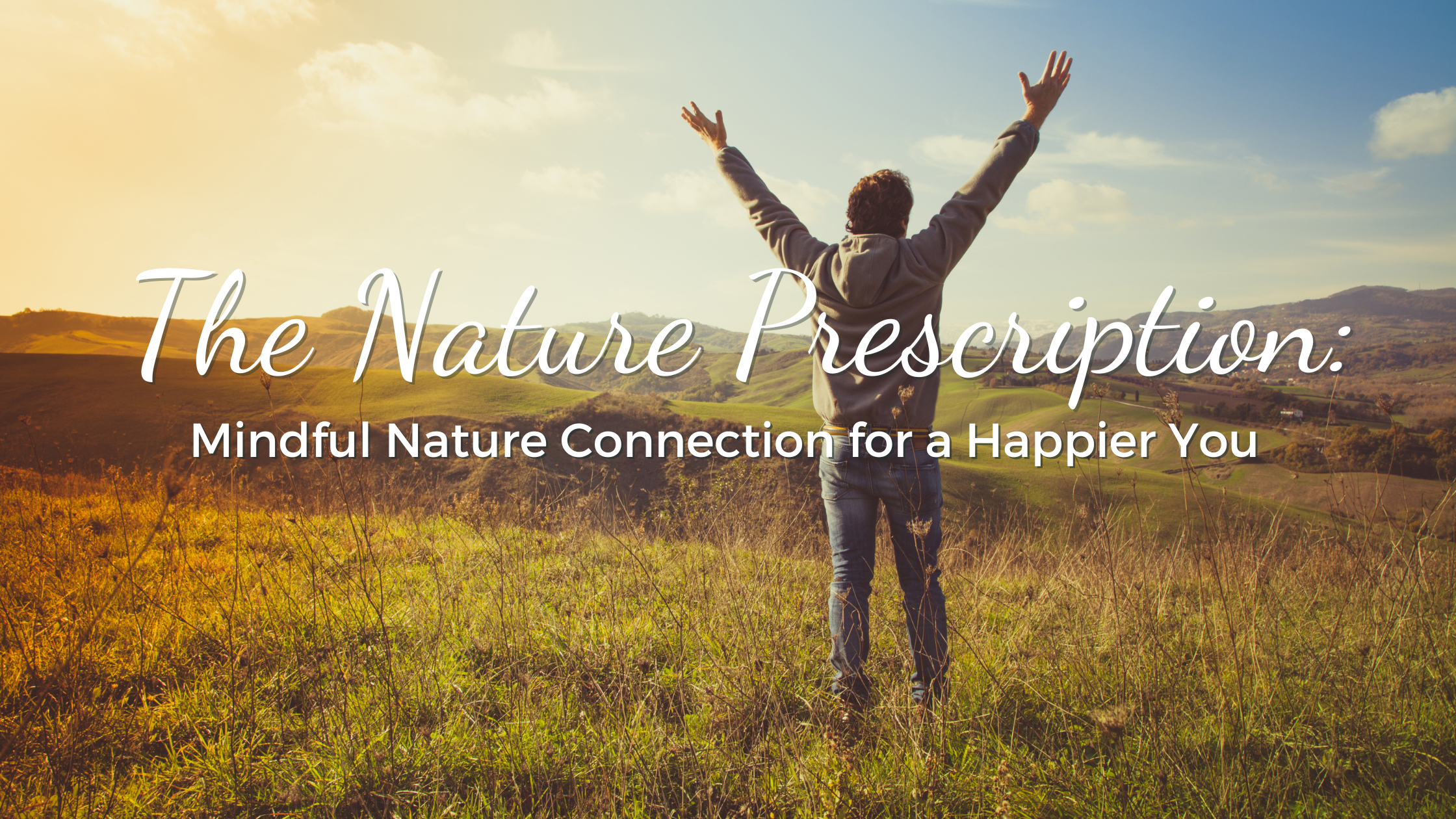The Nature Prescription: Mindful Nature Connection for a Happier You
Step into a world where well-being blooms in the embrace of nature. Welcome to "The Nature Prescription: Mindful Nature Connection for a Happier You." In the hustle of modern life, we often forget the healing power that surrounds us – the whispering leaves, the dancing sunlight, and the calming rustle of the trees. Join me on a journey where we explore the art of mindful connection with nature, unravelling the secrets to a happier, more fulfilled life. It's time to script your own prescription, one written by the soothing hand of nature. Let's embark on this transformative adventure together. Ready to unlock the gateway to joy? Let's dive in.
Understanding Nature Connection: A Therapeutic Approach
In the rush of daily life, the term "nature connection" often echoes as a distant murmur, lost in the cacophony of urban existence. However, as we delve into its profound meaning, we discover a therapeutic embrace that transcends the ordinary. Nature connection, as defined by Derby University, is more than a leisurely stroll in the park or a scenic landscape; it's a profound and intentional interaction with the natural world. It encompasses a deep, reciprocal relationship where the individual becomes an active participant in the dance of nature, recognising its rhythms and harmonising with its melodies.
Embarking on this therapeutic approach involves more than just physical presence in natural surroundings. It's a mindful engagement that encourages us to attune our senses to the gentle rustle of leaves, the fragrance of blooming flowers, and the subtle shifts in the environment. As we understand the intricacies of nature connection, we unlock a gateway to healing that extends beyond the superficial and taps into the profound.
Picture yourself immersing in a forest, not merely as an observer but as an integral part of the ecosystem. This is the essence of therapeutic nature connection—a communion that soothes the mind, uplifts the spirit, and fosters holistic well-being. As we explore the layers of this approach, we unearth the therapeutic benefits that lie in the intentional intertwining of our human experience with the natural world. It's a journey that promises not just a momentary escape but a sustained and transformative relationship with the healing energies of nature. Join me on this expedition into the heart of nature connection, where the therapeutic embrace awaits.
Discussing the Therapeutic Benefits of Immersing Oneself in the Natural World
As we navigate the fast-paced currents of our daily lives, the therapeutic benefits of immersing oneself in the natural world emerge as a beacon of solace and rejuvenation. Derby University's understanding of nature connection delves into the transformative power that lies within intentional engagement with the outdoors. When we immerse ourselves in nature, it becomes a sanctuary for the mind and soul. The therapeutic benefits unfold as we allow ourselves to let go of the stresses that bind us, replacing them with the soothing balm that nature generously offers.
Nature immersion serves as a profound antidote to the modern epidemic of stress, anxiety, and mental fatigue. The natural world becomes a therapist, offering a prescription of tranquility and healing. From reducing cortisol levels to enhancing mood and fostering a sense of calm, the therapeutic benefits are as diverse as the ecosystems themselves. Scientifically backed studies illuminate the positive impact of nature on mental well-being, highlighting its ability to elevate mood, enhance cognitive function, and even boost creativity. It's a holistic therapy that not only addresses the symptoms but also touches the core of our well-being, guiding us towards a happier, more balanced life. As we embark on this exploration of the therapeutic tapestry woven by nature, we uncover the myriad ways in which immersing ourselves in the natural world becomes a profound and essential aspect of our mental and emotional health.
Nature's Impact on Mental Health: Breaking Down the Science
In our quest for a deeper understanding of the profound interplay between nature and mental health, it is imperative to delve into the scientific realms that underscore the positive influences of nature on our well-being. The intricate dance of chemicals in our brain, the delicate balance of neurotransmitters – all find a harmonious rhythm when we immerse ourselves in the natural world. Derby University's exploration of nature connection is not merely anecdotal; it's anchored in the robust foundation of scientific inquiry, drawing on reputable studies to illuminate the intricate web of connections.
Numerous studies, including research conducted by the University of Michigan's School for Environment and Sustainability (2019) and a comprehensive meta-analysis published in the Journal of Environmental Psychology (Bowler et al., 2010), have illuminated the tangible and measurable benefits of connecting with nature for our mental health. These studies showcase compelling evidence, demonstrating nature's role in reducing symptoms of stress and anxiety, improving mood, and enhancing cognitive function. As we dissect these scientific aspects, we unravel the mechanisms through which nature acts as a therapeutic agent for the mind. The release of endorphins, often referred to as the 'feel-good' hormones, is just one facet of this intricate relationship. Join me as we navigate through the empirical landscape, where scientific findings converge to affirm what our instincts have always whispered – nature has an unparalleled power to nurture our mental health. It's not just a subjective sense of well-being; it's a scientifically substantiated prescription for a healthier, happier life.
The research conducted by Derby University identified five distinct pathways that contribute to an individual's connection with nature. These pathways, elucidated through two comprehensive online surveys, offer valuable insights into the diverse ways people establish and deepen their bond with the natural world.
1. Contact: This pathway involves actively engaging with nature through the senses, deriving pleasure from sensory experiences like listening to birdsong, smelling wildflowers, or watching the sunset.
2. Beauty: The aesthetic appreciation of nature is a key aspect of this pathway, where individuals engage with the visual allure of natural scenery or express their connection through artistic pursuits.
3. Meaning: In this pathway, nature serves as a symbolic representation, with individuals finding meaning in the natural world. This can include contemplating the significance of nature or interpreting natural signs, such as the arrival of the first swallow of summer.
4. Emotion: Establishing an emotional bond with nature is central to this pathway, involving the expression of love and deep feelings for the natural world. Reflecting on one's emotional connection with nature becomes a significant aspect of this pathway.
5. Compassion: Extending the self to include nature characterises this pathway, leading to a moral and ethical concern for the well-being of the natural environment. This can manifest in actions such as making ethical product choices or advocating for animal welfare.
The research emphasises that these pathways significantly predict an individual's level of connection with nature, with activities focused on engagement, emotion, meaning, and compassion playing pivotal roles in fostering a strong and meaningful relationship with the natural world. Importantly, knowledge-based and utilitarian or dominionistic activities were not found to be directly related to nature connection.
Finding Nature's Embrace Amidst Urban Landscapes
Feeling a close connection with nature is not reserved for those residing in rural landscapes; it extends its embrace to the heart of towns and cities. The notion that nature connection can be simple, woven into our everyday lives, challenges the misconception that one must venture into the wild to establish a meaningful relationship with the natural world. Derby University's exploration unveiled the profound impact of seemingly uncomplicated activities – watching clouds, stargazing, witnessing the sunrise, listening to birdsong, and inhaling the fragrance of flowers. These ordinary yet profound experiences cultivate a deeper connection with nature, and the beauty lies in their accessibility, even within the bustling confines of urban environments.
In a separate study involving a randomised controlled trial with 582 adults, the focus shifted to the therapeutic effects of noticing urban nature. Participants were encouraged to appreciate the positive aspects of nature found within the fabric of urban environments for seven days. The results were striking – not only did participants experience an improvement in their mental health, but this positive effect endured for at least a month. This revelation serves as a testament to the transformative power of simply acknowledging and appreciating the nature that exists within the very spaces where we live our daily lives. It underscores the potential for urban environments to be rich reservoirs of well-being, offering a reminder that nature's healing touch is accessible to all, irrespective of their geographical setting.
Enhancing Nature Connection Increases Willingness to Preserve the Environment
Individuals who foster a deeper connection with nature are more inclined to actively contribute to its preservation. The research has uncovered a robust correlation between an individual's level of nature connectedness and their propensity to take actions or make choices that align with the well-being of the natural world. Extending beyond the findings, additional research emphasises the significance of this connection. In a study focusing on children aged 9-11, it was revealed that the level of environmental knowledge explained a mere 2% of the variance in pro-nature behaviour. In contrast, the level of nature connectedness emerged as a far more influential factor, explaining a remarkable 69% variance in pro-nature behaviour.
The compelling evidence doesn't stop there. A comprehensive analysis of 75 studies has established a causal link between nature connection and pro-environmental behaviours. This reinforces the notion that the depth of an individual's connection with nature plays a pivotal role in motivating actions that contribute positively to the environment. It underlines the transformative potential of fostering a strong bond with the natural world, not just for personal well-being but for the collective benefit of the planet we call home.
Ways to Apply the Five Pathways to Nature Connection:
Connecting through the Senses:
- Listening to birdsong
- Smelling wildflowers
- Watching the breeze in the trees
- Going barefoot
- Tasting the fruits of nature
Creating Meaningful Interactions:
- Crafting a story about a tree
- Mapping the journey of a bee
- Exploring folktales about nature
- Celebrating key moments like the longest day or the first swallow of summer
Finding Joy in Wildlife:
- Observing wildlife at play
- Taking moments to feel calm with nature
- Wondering at details, like a spider's web
- Reflecting on feelings and sharing them with others
Expressing Creativity:
- Creating wild art
- Painting the amazing colours of insects
- Taking a photo of a flower
- Visiting a place with an amazing view
Taking Positive Actions:
- Planting wildflowers
- Participating in a beach clean
- Digging a pond
- Putting up a nest box
- Supporting conservation charities or buying eco-friendly products
Exploring New Activities:
- Stargazing
- Foraging groups and wild food recipes
- Wild swimming and fun activities in water
Embracing Traditions and Customs:
- Engaging in traditional customs and crafts, such as green woodworking
- Celebrating traditions and moments in nature, like the solstices and when flowers are in season
Creative Workshops:
- Participating in mindful nature walks
- Engaging in mindful photography
- Trying activities that encourage reflection or a response to nature




